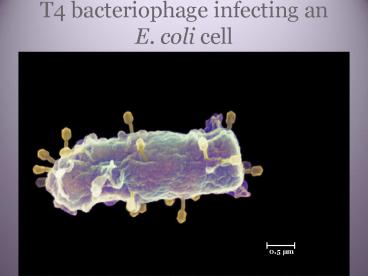T4 bacteriophage infecting an E. coli cell - PowerPoint PPT Presentation
1 / 37
Title:
T4 bacteriophage infecting an E. coli cell
Description:
Title: Genetics of Bacteria Author: Ruth Gleicher Last modified by: klemoine Created Date: 12/13/1999 6:31:14 PM Document presentation format: On-screen Show (4:3) – PowerPoint PPT presentation
Number of Views:235
Avg rating:3.0/5.0
Title: T4 bacteriophage infecting an E. coli cell
1
T4 bacteriophage infecting an E. coli cell
2
Comparing the size of a virus, a bacterium, and
an animal cell
3
Basic shapes of bacteria
- Bacillus ? rod-like
- Coccus ? round
- Spirillium ? spiral
4
Roles of non-pathogenic bacteria
- Some examples
- Decomposition
- Intestinal mutualistic relationship
- Food prep
5
Genetics of Bacteria
- Bacterial genome ?
6
Genetics of Bacteria
- Bacterial genome ? One circular DNA molecule
- E. coli chromosome has 100 times more DNA than in
a typical virus, but much less than a eukaryotic
cell. - Packed into nucleoid region of cell
- Plasmid ?
7
Genetics of Bacteria
- Bacterial genome ? One circular DNA molecule
- E. coli chromosome has 100 times more DNA than in
a typical virus, but much less than a eukaryotic
cell. - Packed into nucleoid region of cell
- Plasmid ? small circular extra piece of DNA
8
Bacterial Genetic Recombination
- What is the main source of genetic recombination
in bacteria? - Mutations
- What are the other sources of recombination?
- Transformation
- Transduction
- Conjugation
9
General steps to transformation
- Isolate gene of interest using restriction
enzymes - Expose recipient bacterium to same restriction
enzyme, temperature shock, ions, and DNA binding
protein - Combine gene of interest with recipient bacterium
10
Transformation ? uptake of naked, foreign DNA
11
(No Transcript)
12
Transduction bacterial genes moved from one host
to another
What is the vector of transduction? A phage
13
(No Transcript)
14
Bacterial conjugation
15
Conjugation
- Defined as the direct transfer of genetic
material between 2 bacterial cells that are
temporarily joined - male bacterium uses a sex pilus to pull
female bacterium towards it creating a mating
bridgeserves as the avenue for DNA transfer - There needs to be a fertility (F) gene present
either as part of the bacterial genome or as a
plasmidan F plasmid is an episome - ? genetic element that can replicate
independently or as part of the bacterial genome
16
Conjugation
17
(No Transcript)
18
- Plasmid genes are advantageous to the bacteria
that have them - Plasmids that confer resistance to antibiotics
are called R plasmids
19
Transposons
- Jumping genes (do not exist independentlyeither
a part of a plasmid or the bacterial chromosome) - Does not depend on complementary base pairing
between homologous regions of the chromosome. - Transposons move to regions that the gene has
never been (ex. plasmid ? chromosome)
20
Transposase recognizes the inverted repeats
21
Targeted inverted repeats are cut, and the target
is cut, then the transposon is inserted
22
Composite transposons move extra genes along with
the inserted sequence, and are very beneficial to
the bacteria
23
Operons
- Regulatory systems in E.coli
- 2 Types Repressible or Inducible
- 5 components
- Regulatory gene (codes for mRNA to be translated
into repressor protein) - Promoter (site on gene where RNA pol. binds to
begin transcription) - Operator (on/off switch)
- Repressor (binds to the operator to turn operon
gene off) - Corepressor (allosterically binds to repressor to
change shape of repressor to turn the operon gene
off) - OR
- Inducer (allosterically binds to the repressor to
change the shape of the repressor to turn the
gene on)
24
Regulation of Gene Expression
Structural Genes
25
Repressible operons
- Repressible operons have structural genes that
code for the production of the substrate.
(anabolic pathways) - The repressor protein is produced in an inactive
form, leaving the operator open and the genes on - In the presence of the substrate, the substrate
will allosterically bind to the repressor protein
(is a co-repressor) and activate the repressor
protein causing it to bind to the operator to
turn the genes off
26
(No Transcript)
27
(No Transcript)
28
Inducible operons
- Inducible operons have structural genes that
produce enzymes that break down the substrate.
(catabolic pathways) - The repressor is translated into its active
configuration and will bind to the operator in
the absence of the substrate to keep the gene
off. - If the substrate is present, it binds to the
repressor protein and de-activates it, thereby
opening up the operator and turning the gene on.
29
(No Transcript)
30
(No Transcript)
31
Glucose and its affects on the lac operon
- E.coli would prefer to use glucose as its fuel
- If glucose is scarce, cyclic AMP is abundant and
serves as an allosteric activator to a regulatory
protein called CAP ? stimulates RNA pol and
transcription of enzymes that metabolize lactose - If glucose is availabe, cyclic AMP (cAMP) is
absent ? CAP detaches and transcription of the
enzymes to metabolize lactose occurs at a very
low level - Lac repressor molecule turns operon genes on or
off, CAP controls the rate of transcription
32
(No Transcript)
33
(No Transcript)
34
(No Transcript)
35
(No Transcript)
36
(No Transcript)
37
(No Transcript)































